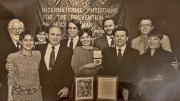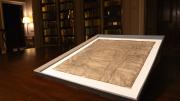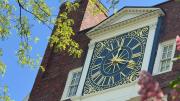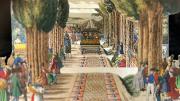In 1207 an elderly scribe in the Armenian kingdom of Cilicia completed the Garabed Gospel. Although blinded by the 11-year undertaking, he completed the 250 inked, goat-skin pages, with decorative marginalia, at a monastery near what is now southern Turkey and gave it to a priest. For the next 700 years, the manuscript was passed down through that family lineage of priests, serving as a sacred object, according to the Armenian Museum of America, in Watertown, Massachusetts, where the volume is now on display. “If one became sick, one would ask the family for ‘the blessing of the book’ to cure their disease. A supplicant would rub a piece of bread or a rag on the Gospel Book,” a museum plaque explains. “If the bread was eaten by the afflicted, or the rag was worn against their body, it was thought to cure the disease.”
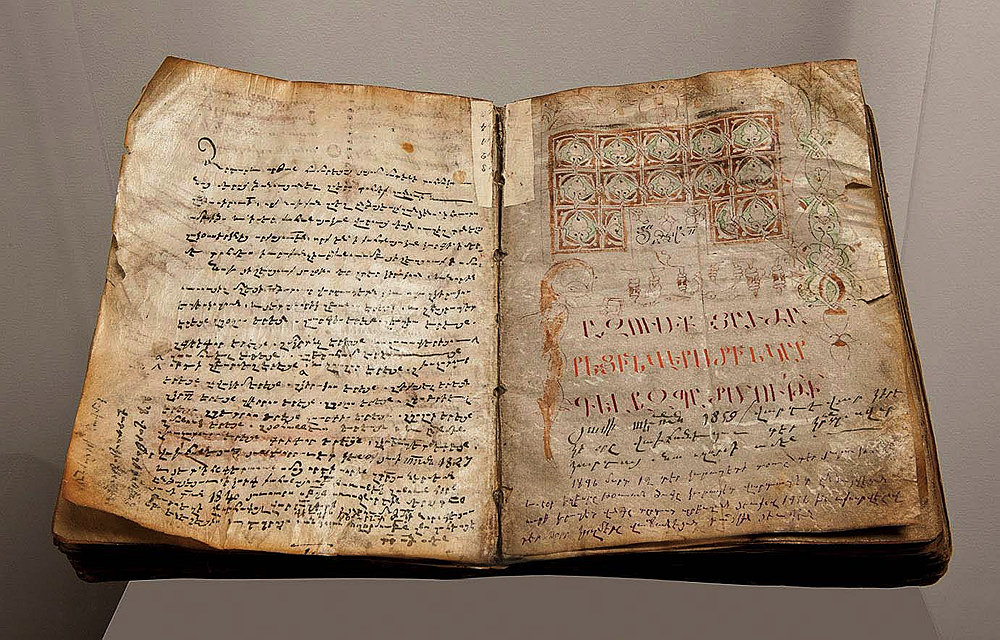
1207 Garabed Gospel
Photograph courtesy of the Armenian Museum of America
It is the museum’s oldest book, says executive director Jason Sohigian, A.L.M. ’11, and survived the looting and destruction of other texts, art, cultural objects, and whole villages by the invading Turks over the years. The museum’s collection of more than 25,000 objects elucidates some 3,000 years of Armenian history and culture, from the early days of Christianity (Armenians were the first to accept Christianity as a state religion) to the contemporary global diaspora. That includes 5,000 ancient and medieval coins and pre-Christian pottery and metalwork, along with liturgical manuscripts and objects, rugs, lacework, embroidery, and artifacts from the World War I-era genocide. More contemporary are the museum’s series of famous portraits by Yousuf Karsh, underground works from the Soviet era (donated by Norton Townshend Dodge, Ph.D. ’60) and, surprisingly, a handful of oil paintings by the American pathologist, and pioneering right-to-die with dignity proponent, Jack Kevorkian, whose mother escaped the genocide.
“Many of the objects in our collection and on display are survivors of history,” says Sohigian. “Armenians have inhabited those lands for thousands of years, and our cultural heritage has been under threat especially in recent centuries. Our museum is unique in that it preserves and displays many of these artifacts that tell the story of Armenian resilience, creativity, culture, and survival over millennia on the territory known as the Armenian Highland.”
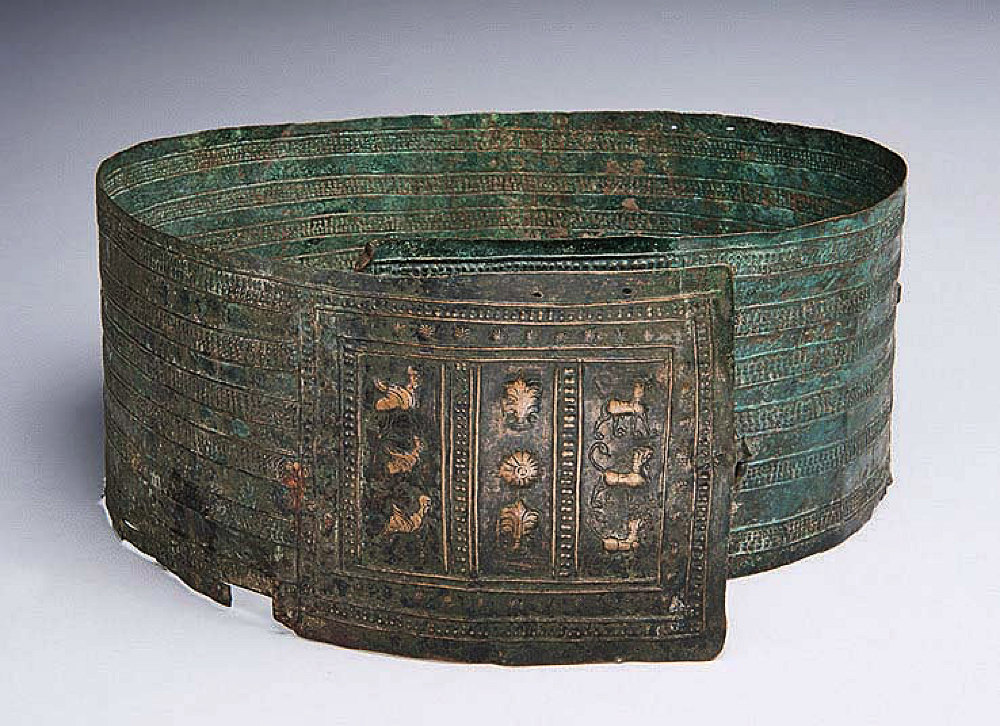
Bronze belt with protective symbols
Photograph courtesy of the Armenian Museum of America
That mission, of bridging gaps between ancient and modern identities, “is not easy or unproblematic, as we know,” says Tufts professor of art and architecture, Christina Maranci, Dadian and Oztemel chair in Armenian art and architectural history, and an academic adviser to the museum. “It is best, in my view, to let the objects speak for themselves,” she says. “The Garabed Gospels…does this well: its colophon records its initial production by the scribe Garabed, successive owners and users over generations, indeed centuries, as well as its vandalization during the Genocide.”
The museum’s “extraordinary collection,” she adds, is both under-researched and under-studied, but is instrumental in chronicling and bearing witness to rich aspects of world history. She highlights the late fifteenth-century hymnal illuminated by Karapet of Berkri, a famous medieval artist and scribe from the Vaspurakan region (the cradle of Armenian civilization, now within the borders of Turkey and Iran), and an eighteenth-century altar curtain made from wooden block prints for a church of Saint George in Mardin as “testifying to circulation of objects across the Armenian communities in the Ottoman Empire.” A priest’s cope (shurchar), made in Surabaya for a wealthy Armenian trading family, as one of her students discovered during a research seminar, “combines traditional Indonesian batik fabric with an Armenian inscription, speaking eloquently to the dynamics of cultural exchange in the early modern world, and the role of Armenians within it.”
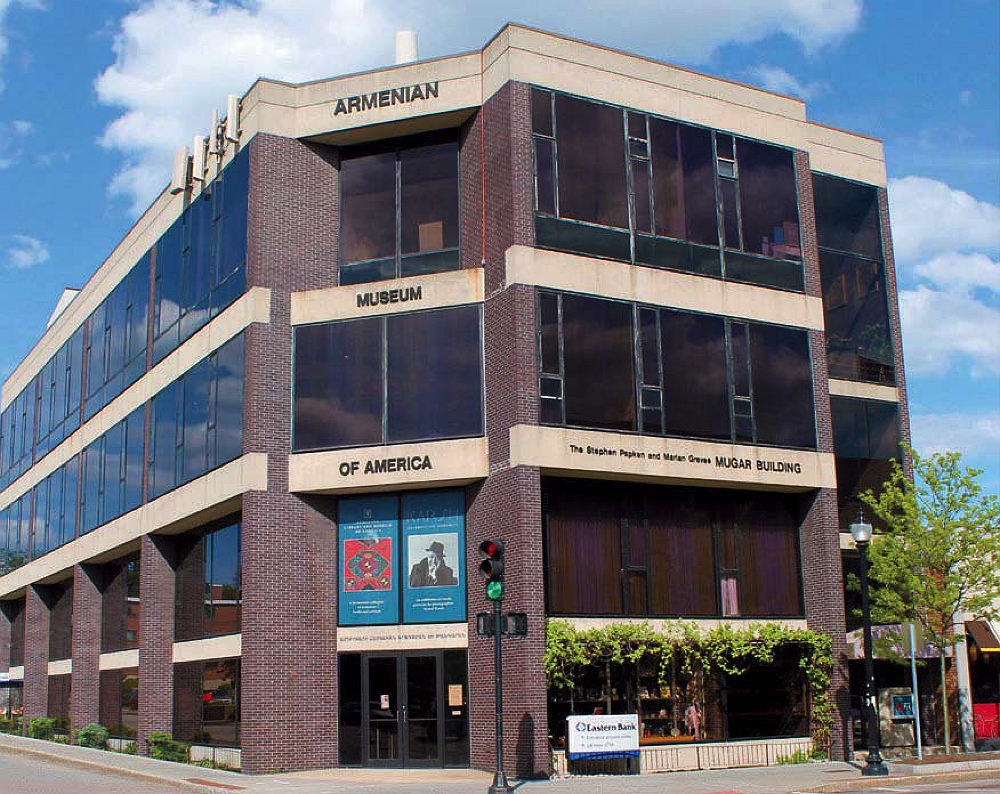
The museum's Watertown Square façade
Photograph courtesy of the Armenian Museum of America
Scholarly value aside, the museum is a powerful experience for visitors, no matter how familiar they are with Armenian culture and history. It’s a testament not only to the layered ancient world, but to a peoples’ resilient drive to survive and flourish despite historic genocide and other forms of destruction. The local effort to find and preserve elements of this heritage began in 1971 when a small group of Armenian Americans first gathered contributed items in the basement of the First Armenian Church in Belmont, Massachusetts.
The state has long been home to the nation’s second-largest Armenian American population, with about 30,000 residents of Armenian heritage living primarily in Boston, Worcester, and Watertown. Los Angeles is home to 205,000 residents of Armenian descent (Cherilyn Sarkisian, better known as Cher, and the Kardashian clan among them), but has no museum. The Watertown institution’s founders eventually bought a former bank building, a brutalist structure designed by Ben Thompson, of The Architects’ Collaborative, in Cambridge, stored valuable items in existing vaults, and began opening exhibits to the public in 1991, the same year Armenia declared independence from the Soviet Union.
Preservation of materials connected to Armenia is a continuing effort, Sohigian notes. In September 2020, the museum took a stand against the “resumption of war” and the threats against Armenian culture in the Artsakh region, expressing “solidarity with colleagues in the scholarly and cultural heritage community around the world, who are calling attention to the threat of cultural genocide and ethnic cleansing in Artsakh.” The 44-day war in that region, also known by its Russian name Nagorno Karabakh, began on September 27, 2020, and was led by the Republic of Azerbaijan with Turkey’s military support and Syrian jihadist mercenaries. The war was halted by a trilateral agreement, and Russian peacekeeping troops currently occupy the region, although remaining Armenians face a precarious future.
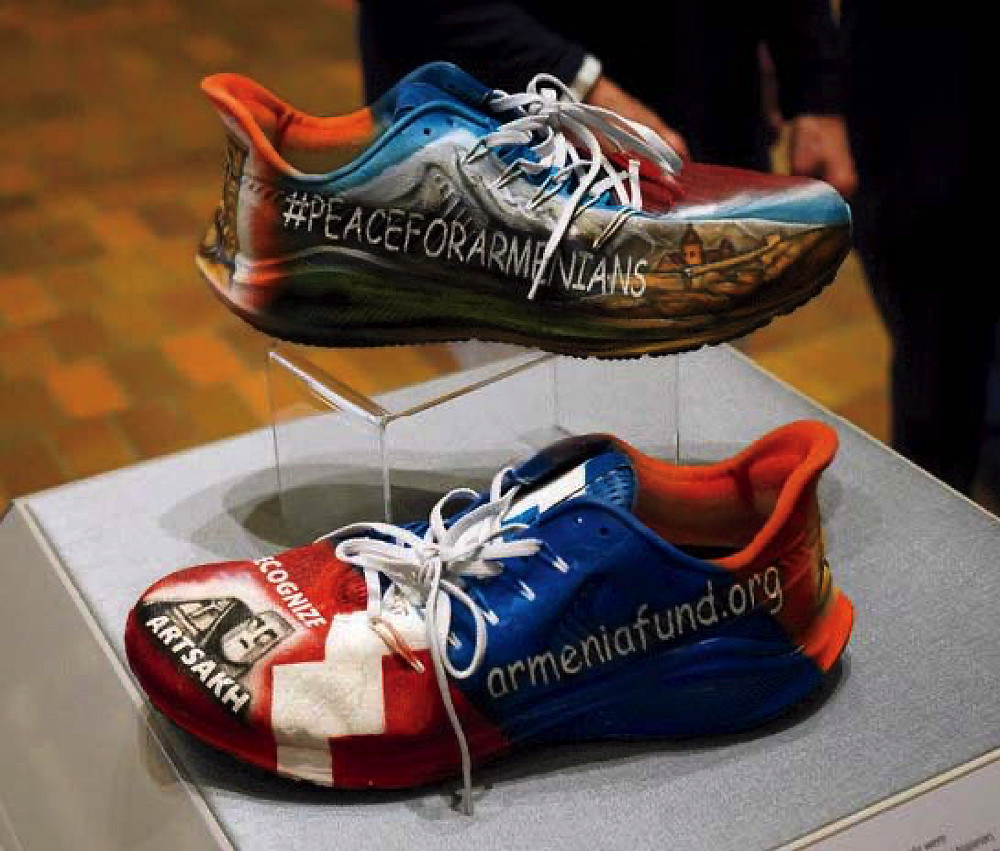
Artfully painted NFL cleats on display bear iconic Armenian imagery.
Photograph courtesy of the Armenian Museum of America
Joining the effort to draw attention and aid to the political crisis, the museum spotlights, near the entrance, an artful pair of #PeaceForArmenians cleats. Donated for the NFL’s “My Cleats, My Cause” program by the New England Patriots’ director of football/head coach administration Berj Najarian, an Armenian American, the cleats are painted with Armenian iconic imagery by Massachusetts artist Joe Ventura, and were auctioned off to support the Armenia Fund. They were bought and donated by museum president Michele Kolligian and vice president Bob Khederian. Nearly all of the items have been gifts, notably from Paul and Vicki Bedoukian.
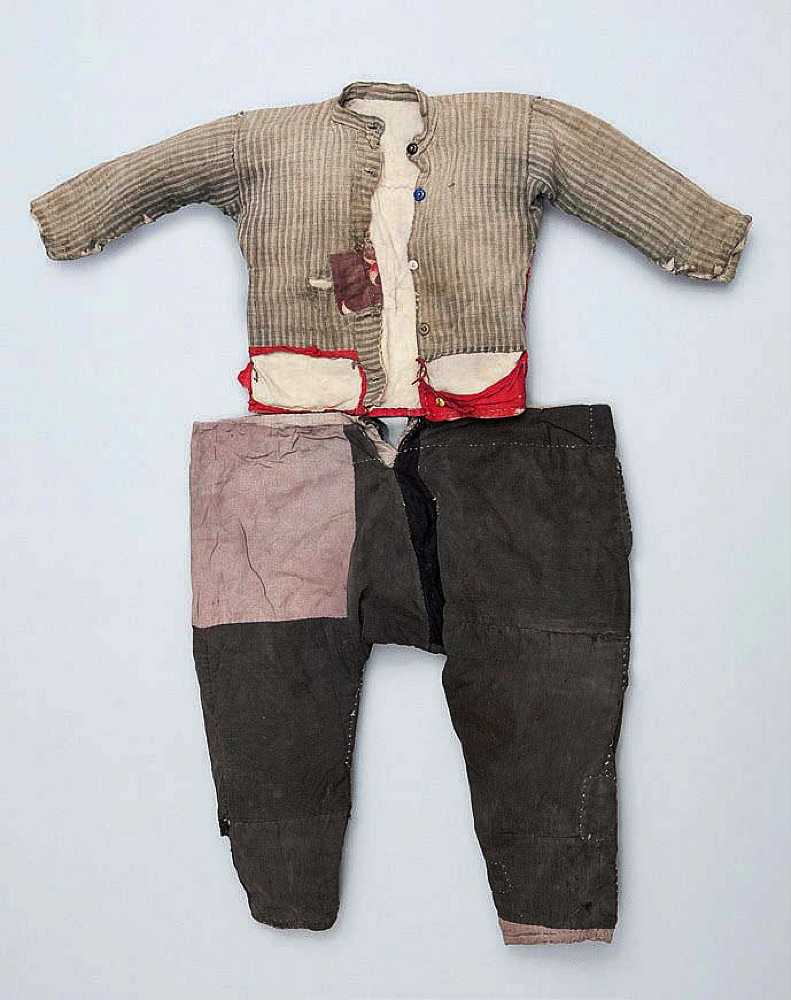
Clothing recovered from a genocide victim in the Syrian desert
Photograph courtesy of the Armenian Museum of America
Among the most stirring objects are in the exhibit about the Armenian Genocide of 1915-1916. During this period, Armenians living in the multi-ethnic Ottoman Empire were subjected to arrest and deportation, and otherwise systematically annihilated through massacres, starvation, exposure, and illness. Many were forced to walk to desert regions where they died along the way. The events were finally publicly recognized as genocide by President Joe Biden last year. “The global diaspora was the result of the Armenian Genocide, and the survivors of that generation went on to thrive and prosper,” Sohigian says. “This is a source of pride for us, and we are honored to tell this story to the world.”
Walls depict maps and photographs interspersed with an extensive chronology of both the historic context for the genocide, and the events themselves. But artifacts convey the human toll. “This is an outfit worn by a child victim of the 1915 genocide,” Sohigian says during a museum visit. “And this eighteenth-century Bible was found buried in the Syrian desert, Der Zor,” where deportees died. There are also human bone fragments, a metal collar used as an instrument of torture, handwritten letters, and a folk art crafted by survivors.
The first wave of Armenians to Massachusetts grew out of the spread of American Protestant missionary schools across Anatolia, according to the genocideeducation.org project, but then worsening economic conditions, violence, and forced conscription into the Ottoman army led to a second wave in the 1890s. “The most important destination…was Watertown, where the new Hood Rubber factory opened its doors in 1896. Coinciding with the exodus of Armenians from the 1890s massacres, a direct pipeline developed between the Armenian provinces and east Watertown.” Thousands more arrived in flight from the 1915 genocide such that by 1930 more than 3,500 Armenians lived in Watertown—nearly 10 percent of the population. The community still thrives today, with churches, grocers, a cutural center, and a school.
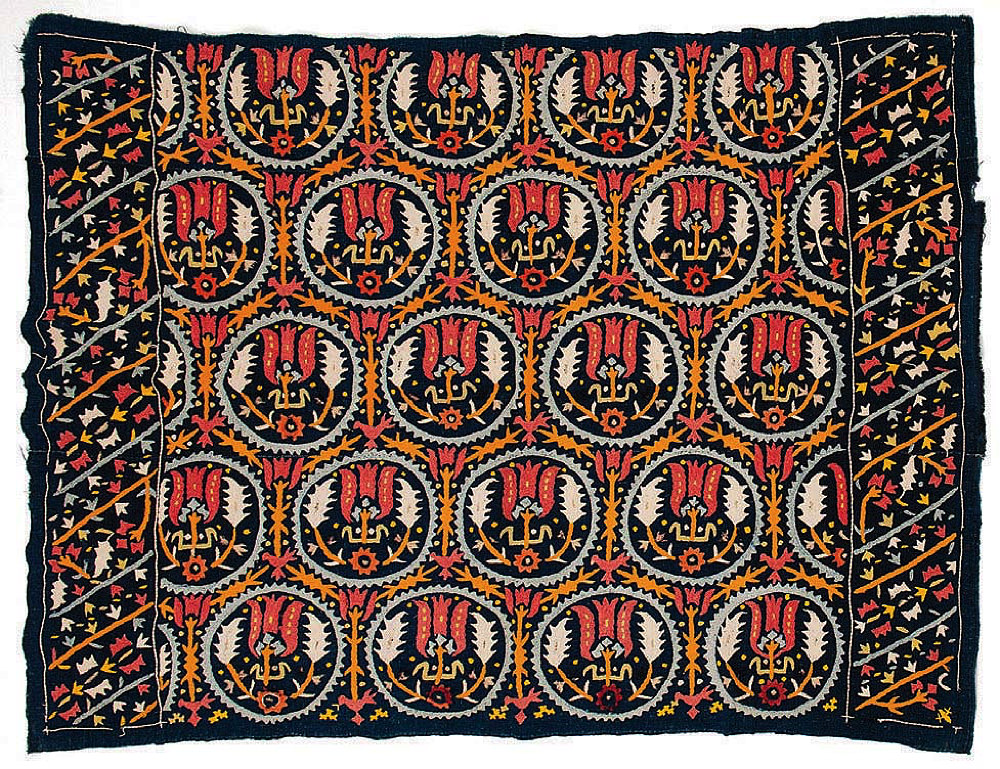
Atlazlama embroidered cover
Photograph courtesy of the Armenian Museum of America
The museum owns hundreds of beautifully hand-woven rugs, several of which are on display, along with traditional apparel and examples of fine needlework. Visitors will see a velvet wedding dress with gold-lace embellishments and a woven belt typical of the women’s clothing of Erzurum, a once-thriving Armenian city that’s now part of eastern Anatolia, Turkey. Embroidered textiles from Marash, in Cilicia, now southeastern Turkey, feature interlaced stitching depicting architectural and natural motifs. There’s also white lacework, liturgical clothing and objects, like the 1813 Hmayil, an illustrated scroll featuring prayers and quotes to help ward off dangers and sickness, and musical instruments. Among them is the indigenous Armenian duduk, an ancient double reed woodwind piece made from apricot wood. Striving to connect this rich past of ancient kingdoms and global migration to the present, the museum typically hosts art classes and year-round in-person activities featuring Armenian food, music, dance, and scholarly talks on its huge, skylighted third floor. Planning is under way for 2022 programs; check the website calendar at armenianmuseum.org for details.
Within that event space, look for the two galleries of striking contemporary art. Dissident Collection of Armenian Art features a painting by the well-regarded Sarkis Hamalbashian, and about 10 works produced in Soviet-era Armenia. They were donated by the foundation for the economist and collector Norton Townshend Dodge, who first traveled to the Soviet Union in 1955, ostensibly as part of his Harvard dissertation, and eventually, covertly, amassed one of the largest collections of Soviet art outside of the Soviet Union. (His activities are narrated in John McPhee’s 1994 The Ransom of Russian Art.)
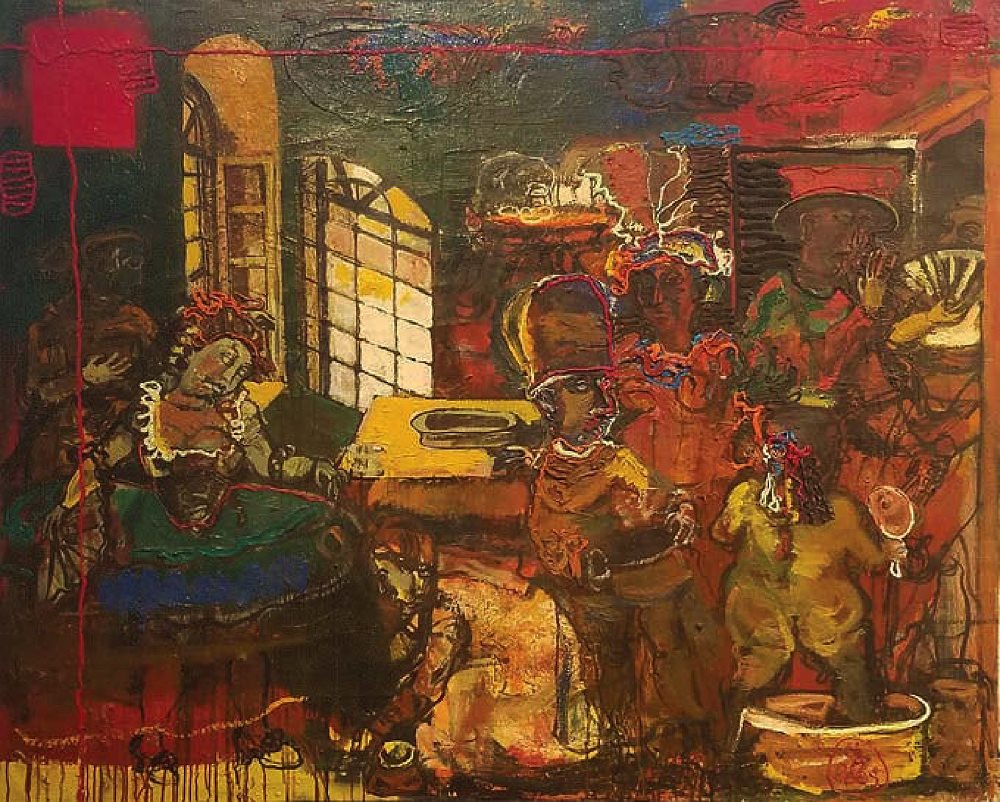
Green Room (2005), by Sarkis Hamalbashian
Photograph courtesy of the Armenian Museum of America
Hanging in the adjacent gallery are the graphic, surrealist Kevorkian works. In addition to his active support of physician-assisted suicide (for which he was convicted of second-degree murder in 1999 and served eight years in prison), Kevorkian was also a jazz musician, composer, linguist, and painter. Of the art displayed, most salient, and framed using human blood, is 1915 Genocide 1945. Kevorkian’s own explanatory label reads, in part: “No collective human action can match the depravity of race murder. To call it bestial would be unfairly lowering the beast…Any such attempt (including this painting) would never convey the real meaning of unlimited murder for the purposes of national extinction, beginning with the American Indians.”
This winter, the museum adds to these contemporary galleries a multimedia exhibit anchored by its recently acquired Armenian cross-stone, known as a khachkar. The object reflects a medieval art form unique to Armenia, and was carved in 2018 by sculptor Bogdan Hovhannisyan for the Smithsonian Institute’s Folklife Festival. “It’s a connection between a modern artist and a tradition; if you go to Armenia now, you will see artists carving these crosses in their workshops,” Sohigian says. “And all these things, the monuments, artifacts, relics, art, are actively being destroyed by Turkey and Azerbaijan now.”
The cross-stone, like the Garabed Gospel painstakingly created in the thirteenth century, stands to preserve cultural history and the collective experience of a displaced, dispersed people. Although the manuscript was seized by authorities when older members of the extended Der Garabedian family, which held the Holy Book for 39 generations, were killed during the genocide, a surviving relative paid a ransom for its return. In 1927, he gave it to a nephew who had emigrated to America, and his surviving daughter, Julia Der Garabedian, entrusted it to the museum. “If we agree that cultural heritage is a human right,” Christina Maranci says, “then we should respect, protect and learn from those communities whose cultures have faced destruction.”

